Time Travelers
The "pulses" of transportation technology
Risk & Progress explores risk, human progress, and your potential. My mission is to educate, inspire, and invest in concepts that promote a better future for all. Subscriptions are free. Paid subscribers gain access to the full archive and Pathways of Progress.
Only a few generations ago, we lived in a world where crossing an ocean or a continent was a perilous, months-long journey. Today, we can cover these distances in a few hours by plane, even if we might gripe about insufficient legroom and subpar food. Humans need to travel, the capability to move our physical bodies from one location to another, and the faster, the better. Since the Industrial Revolution, rising transportation speeds have redefined the boundaries of human ambition and connectivity, fundamentally transforming global societies, economies, and the human experience of distance.
The Time Travel Budget
Transportation analyst and engineer Yacov Zahavi found that humans have a “travel time budget” that holds globally, regardless of race, religion, or time period. It’s an anthropological constant, of sorts, that humans set aside about 1.0 to 1.5 hours per day for travel. In urban transport contexts, this is popularly known as Marchetti’s constant, which states humans, on average, spend about an hour per day commuting. This means that while our “time budget” allocated to travel hasn’t changed, as our technology has increased travel speeds, the radius of travel has been pushed out. This is especially true since the Industrial Revolution. We have become time travelers, of sorts, able to traverse growing distances in less time, and this has altered our perception of time and space.
A remarkable study by Arnulf Grubler and Nebojsa Nakicenovic discusses how, in parallel with the dematerialization of goods, where we reduce the total material inputs required to make useful forms, progress also allows us to reduce the time inputs for travel. They found that, like other technologies, transportation technology evolves along S-curves defined by an initial period of experimentation, a rapid growth phase, and then a saturation phase where further development is largely exhausted. From there, each transportation system begins to decline, giving way to another breakthrough mode of transport technology.
A History of Human Travel
The foundational mode of human travel is, obviously, our own two feet. As we know, humans evolved to walk upright; we are bipedal animals. This, of course, freed our hands to do useful things, but greater upper-body utility came with a trade-off: less agility and speed on the ground. Quadrupeds are generally faster than we bipeds; they can outrun and outwalk us. Humans are limited to a sustained walking speed of roughly 5 kph. This limited the range that we could travel in a single day, and the more time spent travelling, removed from the familiarity and security of home, the more dangerous the journey became. For most of us, long-distance travel was not worth the risk.
Of course, we know that human cognitive prowess compensates for every physical limitation, and then some. While we couldn’t out-travel a quadruped, we could tame them and use their abilities for our ends. A typical horse, for instance, can trot about twice as fast as a human, with sustained speeds of about 10 kph. It was for this reason that horses became the animal of choice for riding and pulling carriages. We also leveraged the power of wind and water by building canals; it was simply easier to travel great distances over water than over land. Canals were pre-industrial highways, at least before steam engines were compact and efficient enough to make railways a possibility.
The Industrial Revolution was a sea change event on many fronts, and this included transportation. By leveraging the energy stored in fossil fuels and utilizing heat engines, we built machines that would take us further and faster than nature would otherwise allow. In the early 19th century, the first steamships and locomotives began traversing the planet. Initially, they represented only a modest improvement over the horse and sail. The 1825 Stockton and Darlington Railway, for example, operated at around 16 kph, but by the 1830s, the first modern steam-powered locomotive, the “Rocket,” could operate at speeds of 45 kph. By the end of the 19th century, it was not uncommon for steam traction to haul people and cargo at speeds approaching 100kph, a 1900% percent increase in human travel speed in just a century.
Improved engines, including more efficient diesel engines in the early 20th century, pushed train efficiency and speeds higher than was possible with steam. Then, after 1950, diesel-electric trains became the norm, whereby the train wheels were driven by electric motors supplied by electricity from a diesel engine connected to a generator. This pushed efficiency higher still as the diesel engine could operate continuously at its optimal rpm. After 1975, high-speed rail took this concept further, supplying electricity directly from the track, eliminating the need for a diesel engine and for carrying fuel. Combined with more aerodynamic profiles that cut through the air with ease, modern high-speed rail could transport people at 200 kph.
The golden age of railways, however, peaked for leading-edge countries around 1930. Train travel was initially supplemented, then largely replaced, by the automobile and truck. The automobile, of course, was an outgrowth of several innovations, including the more efficient and compact internal combustion engine. The automobile wasn’t necessarily faster than a train in terms of cruising speed, but it could still reduce travel time by transporting its contents directly to its final destination, not to a station that would require a separate mode of travel. Automobiles were also cost-effective and flexible enough to run in lower-density areas, greatly expanding the breadth of their reach, which we will discuss in a moment.
The Industrial Revolution also dramatically changed sea travel. Preindustrial sailing ships were limited to an average operating speed of around 8 kph, dependent upon the weather and wind direction. Innovations like copper hull plating increased sailing speeds by about 50%, or to 11 kph, by 1800. Early steam-powered ships, however, were less dependent on wind and weather and could outperform even the best sailing vessels, operating at about 16 kph. By the early 20th century, ocean liners like the Lucitania crossed the ocean at around 40 kph, and later ocean liners could exceed 50 kph. Incidentally, due to its replacement by air travel, there has been essentially no improvement in passenger sea travel speed since then; modern cargo freighters prioritize efficiency instead.
Not all was lost, of course, for in the 20th century, travel technology soared into the skies. The first powered flight was achieved by the Wright Brothers in 1903; it didn’t take long for innovators to realize that they could dramatically shrink the world by flying above it. Flying could avoid obstacles on the ground and simultaneously dematerialize most of the transportation infrastructure. There was no canal to dig, no road to pave, no rails to lay, or bridge to construct. Early prop-driven aircraft, however, couldn’t carry many passengers, were unsafe, uncomfortable, and limited to speeds of 300-400 kph. Improvements came in the wake of the Second World War. The Lockheed Constellation, for example, could operate at speeds of 550 kph and was one of the first passenger aircraft equipped with a pressurized cabin. This was crucial as it allowed the aircraft to safely fly passengers above the weather.
The commercial airline industry wouldn’t come into its own until the late 1950s with the commercialization of jet engine technology. Jets could cruise at speeds of over 900 kph, representing an 800 percent increase in human travel speeds from 1900, or 18,000 percent, from 1800. Speed alone was not the only factor that secured the jet age. Jet engines, compared with their piston counterparts, lasted longer, required less maintenance, and were more powerful. This meant we could build larger planes. For instance, a prop-propelled DC-3 in 1935 could carry 21 passengers at 350 kph, or 7,400 passenger-km/h. Forty years later, the Boeing 747 could carry 500 passengers at nearly 1,000 kph, or 500,000 passenger-km/h.
Beyond speed and size, improving jet engine technology made airliners more efficient, quieter, and cheaper to operate. Jet engines can produce thrust in two ways: they can move a small amount of air quickly (less efficient) or a large amount of air slowly (more efficient). Beginning in the 1960s, most commercial airliners began adopting high-bypass turbofan jet engines, whereby a large “fan,” placed in front of the compressor, did most of the propulsion, pushing 80-90 percent of the air around the combustion chamber. Combined with lighter and more heat-resistant turbine blades made of exotic new alloys, jet engines have been trending lighter and more fuel-efficient for a given amount of thrust.
Transportation Pulses
If we zoom out, what emerges is a series of technological waves or pulses. While it’s obvious that each successive technological leap allowed humans to travel faster, more remarkable is the fact that each was also more expansive than the last; not only could we go faster, we could visit more places. For example, while canal construction in the US began in earnest around 1780, the system reached its peak around 1870 at 6,400 km, before declining. Railway construction kicked off in 1830, and the total rail network peaked about 90 years later, spanning around 400,000 km of rail. Next, the paved road system that carried automobiles proved even more expansive, reaching 4.4 million km by 2025.
Most interesting, however, Arnulf Gubler and Nebojsa Nakicenovic found that when the growth of each network slowed, the “saturation” phase, it appeared to kick off the transition to newer and faster transportation technology. The railway network, for example, peaks just as the automobile enters its growth phase. This, of course, engenders questions of causality. Are newer technologies displacing older ones, or did the maturation of older technologies create an opening for new ones? While the answer is unclear, I lean toward the former because the diffusion of transportation technology is truncated for latecomers. For instance, countries that began building rail lines later tend to have smaller networks than those that built their rail lines before the automobile matured.
In another interesting finding, Grubler and Nakicenovic examined whether decreased travel time, that is, more face-to-face interaction, reduced the demand for long-distance communications. They did this by comparing passenger/km to total communication output in France (letters, telegrams, faxes, phone calls, etc.) They found similar growth rates in both travel and communication, indicating that one did not reduce demand for the other, but instead, communication and travel technology coexisted synergistically. In fact, faster travel times might, in parallel with Jevons’ Paradox, induce more travel. This study, of course, predates the internet, so it is unclear if those findings would hold today.
Grubler and Nakicenovic also discuss the evolving nature of cargo shipments, whereby two interrelated trends, the dematerialization of goods and the improvement in transportation technology, act upon each other. Understand that the dematerialization of goods, through the use of lighter materials, higher energy density storage, more compact packaging, better computers, etc, raises the “value density” of products as measured by (value/kg). As it turns out, each successive transportation technology favors increasingly value-dense cargo. Ships and rail move, for example, low-value-density goods like chemicals, ore, and gravel. Trucks transport mid-value products like machine tools and industrial equipment, while aircraft dominate the transport of high-value products like finished consumer electronics.
The evolution, or pulses, of transportation technology have transformed humans into time travelers. The perception of time and space has been forever altered by our ability to traverse long distances in less time. Simultaneously, the expansion in the breadth of the global transportation network has made more corners of the world accessible to more people than ever before. The world is shrinking beneath our feet. What comes next is unknown. Will supersonic air travel return? Or are we seeing the emergence of a new, quasi-personalized air transportation system in the form of air taxis or eVTOL aircraft? Our future is uncertain; I only hope that travel is faster and more convenient at the close of this century than it was at the beginning.
Next in this series:
Previous:


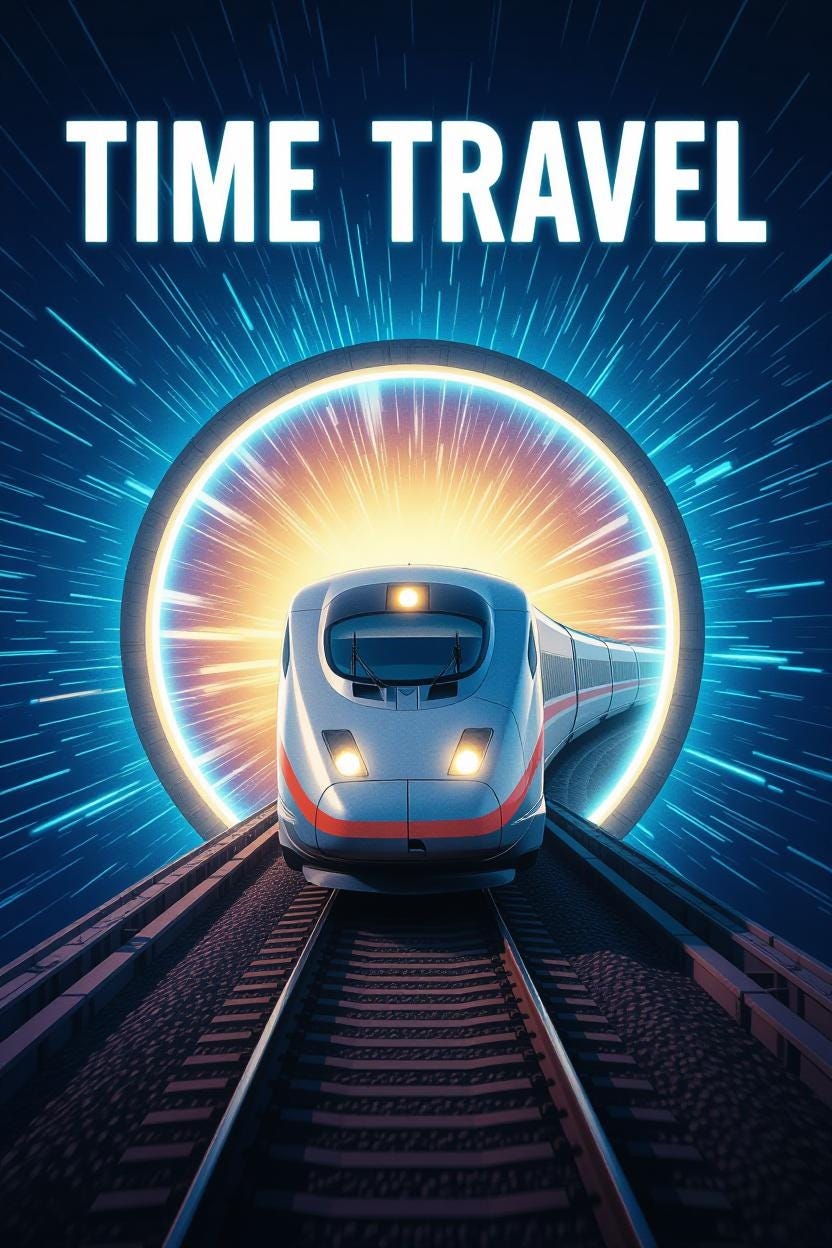
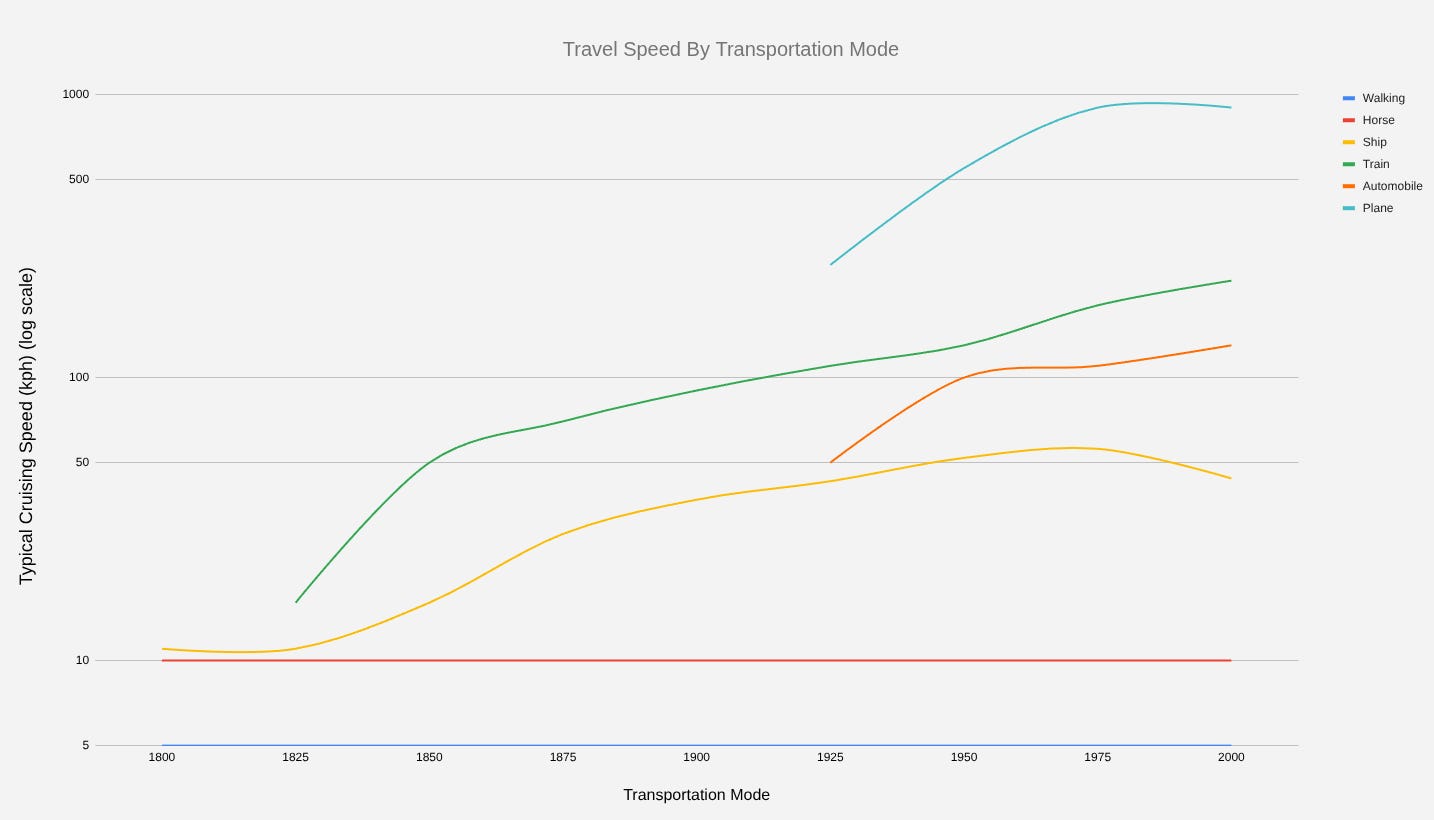
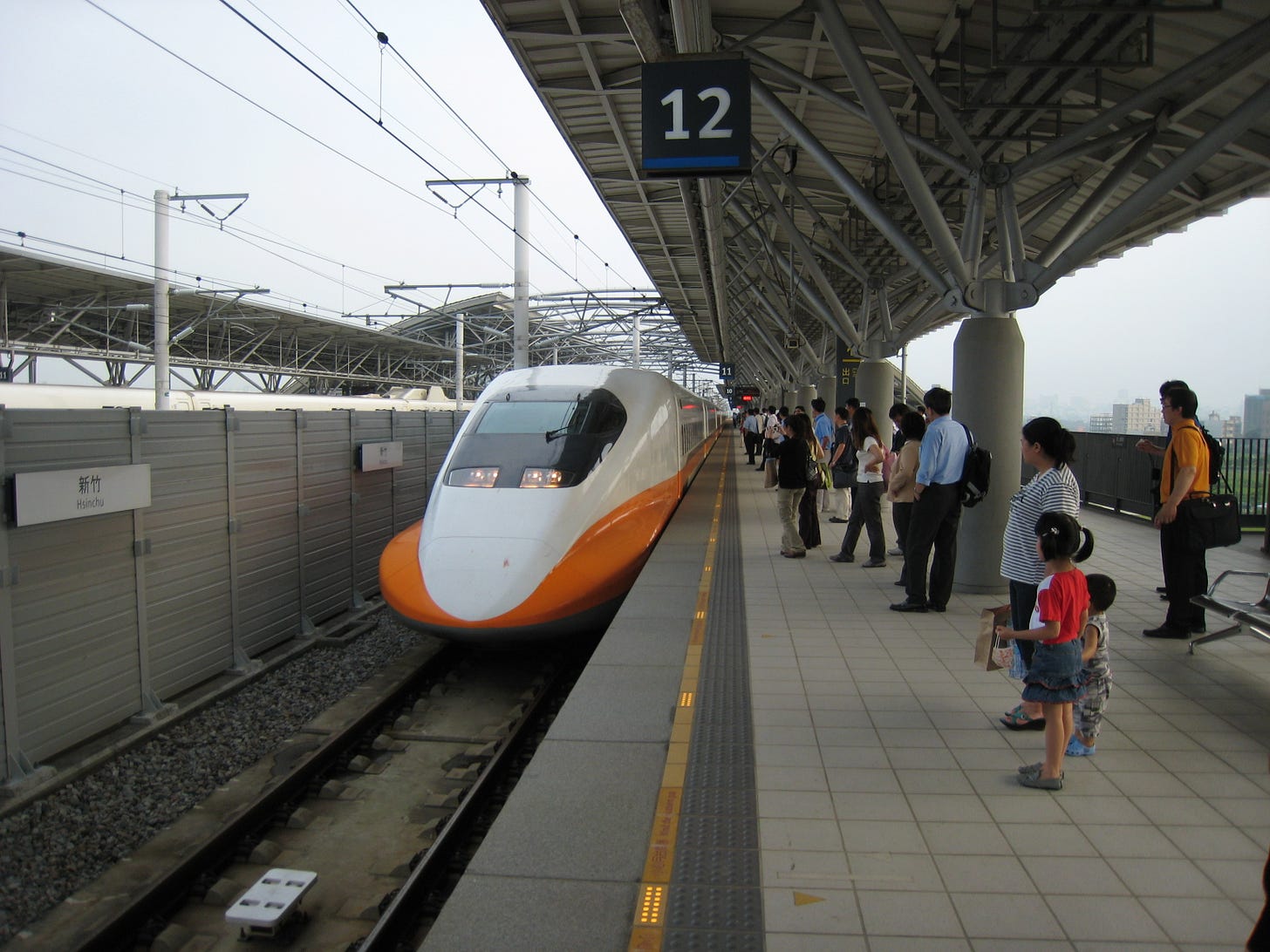
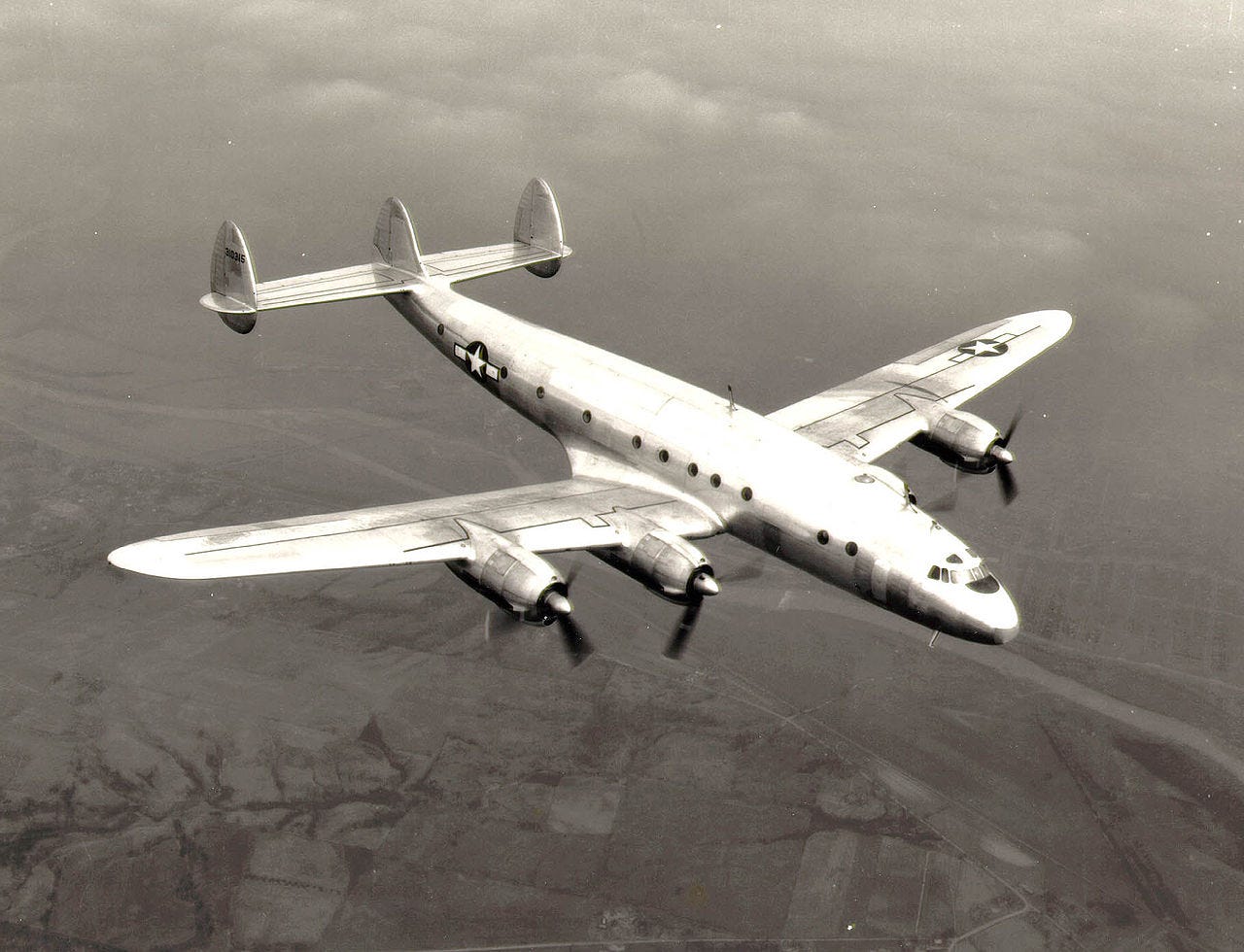
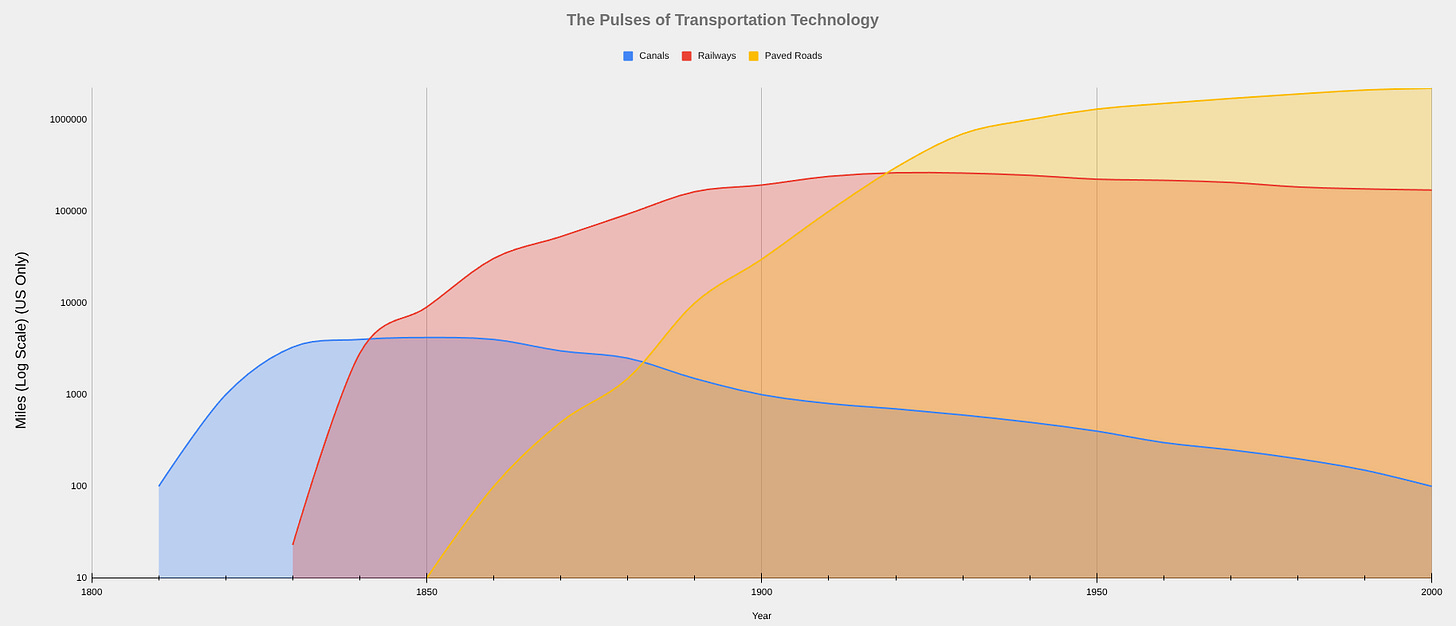

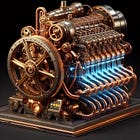
An excellent post!
I think that newer technologies don’t simply replace older ones in many cases; they emerge because mature technologies create the conditions for them, and then both coexist for a time. As the incumbent stabilizes—standards, infrastructure, and costs—new modes start as complements serving specific niches while switching costs keep most users put.
Adoption flips when the newcomer becomes competitive on total cost, convenience, or performance—often offering a step-change on at least one key dimension (for transportation, more extended range in less time or a markedly lower cost per mile). The new technology takes off at that tipping point and captures most of the growth. Older technology rarely disappears; it persists where it’s structurally advantageous or the new option isn’t available or cost‑effective, becoming part of a layered system rather than being entirely replaced.
This is a fascinating analysis of how transportation technology has evolved through distinct pulses. The concept of the constant travel time budget is particularly insightful - it suggests that our behavior is more constrained by time than we might think. What strikes me most is how each technological wave didn't just increase speed, but enabled entirely new patterns of economic organzation and settlement. The transition from canals to railways, for instance, fundamentally reshaped where cities could form and how industries could organize their supply chains.